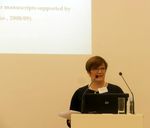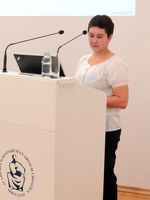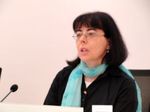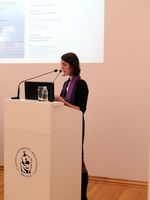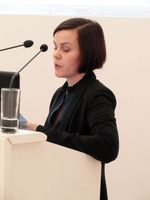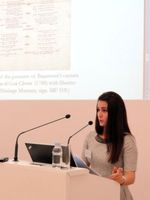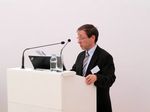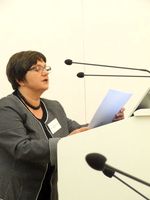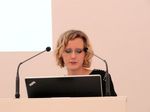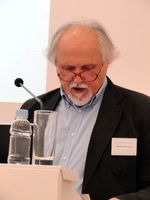International Musicological Symposium of the HERA
Abstracts
Sources of Cantus fractus from Dalmatia:
Examples of Transfer, Adoption and Changes of the Italian Core-repertoire in the 18th Century
The repertoire of cantus fractus represents an abundant collection of monophonic and polyphonic liturgical chants widespread throughout the European regions. It consists of the chants for the Ordinary of the Mass (especially the Credo), hymns, passions and sequences. Italian repertoire has been revalorised and researched recently. Results were published in 2012 in the monograph, Cantus fractus italiano: un antologia (ed. M. Gozzi).
Sources of cantus fractus from Dalmatia are known and studied only sporadically.
This paper will demonstrate the most distinguished examples from Dalmatian manuscripts in comparison with Italian core-repertoire. Results of this first inspection will show concordances and similarities of the Dalmatian Franciscan sources with their Italian counterparts. At the same time, they will demonstrate the differences between these two adjacent Adriatic regions: a manuscript of Istrian origin and some codices from the Franciscan Province of Split will serve as a basis for drawing preliminary conclusions about the peculiarities of Dalmatian canto fratto.
Migrations and Permeations between Two Shores of the Adriatic: The Examples of Zadar, Kotor and Venice (the 17th and the 18th Century)
Migrations are among the more prominent historical factors that have influenced demographic, social, ethno-cultural and mental circumstances in a certain area. Research into migrations, within the scope of historical research, depends on the access to divergent archival sources, and use of various methodological procedures. Therefore, the aim of this paper is to underline archival sources and methodological procedures used by historians for research of migrations in the pre-industrial period, that is, more precisely, in the Early Modern Period. Parish records, testaments and other notarial records and, finally, also the recruitment lists of the Venetian Army will be presented as basic sources. This research is defined in spatial terms on the migrations between the two opposite sides of the Adriatic: as representatives of the East Adriatic centres, Zadar, the capital of the Venetian province of Dalmatia, and Kotor, the centre of Venetian rule in the area South of Dubrovnik have been chosen; and as representative of the West Adriatic, Venice, the metropolis of the area in that period. The research is temporally limited to the 17th and the 18th century, that is, to the period of intensive migrations caused by political, social and economic events, in the first place by the Ottoman presence in the hinterland of the Dalmatian cities and by Veneto-Ottoman warfare. Merchants, artisans, soldiers, clergymen, intellectuals of the most diverse types, and, of course, artists, were among the most frequently mentioned groups of migrants. The analysis of source materials shows that the origin of migrants, declared in the sources, usually represents only a personal identity card of sorts, whereas the places of their professional, but also private, activities – foundation of families and homes – were spread over the wide areas of the Adriatic and Mediterranean basin.
Travellers and Migrants: Musicians around Europe in the Early Modern Age
Music associated with migrations have been considered a peculiar phenomenon of the early 20th century, in particular relation to the national groups arriving in the United States from several European countries, such as Ireland, Italy, the Balkan countries and others, or, later on, as a consequence of the racial persecutions such as those of Jewish musicians from German or Russian lands. More recently, a similar case has been studied with the migrants from Europe to Australia and, but on a minor scale, also with internal migrations in Asia, Africa or the Americas. This field has been widely investigated by ethnomusicologists and entire conferences and books have been produced on the topic. The discussion on the music and displacement of national groups, however, can be applied to the entire history of the globe and involves many categories of movements: from simple mobility and dislocations to the several forms of Migrations and Diaspora (as indicated in the subtitle of the recent book Music and Displacement edited by Erik Levi and Florian Scheding). Other categories can be added, for instance Music and Identity, or the impact of the Tourism on local traditions (also studied in recent publications). The Swiss-Italian scholar, Marcello Sorce Keller, is among the few to have traced a specific methodology in the field of Music and Migrations. The basic question in this kind of research, as put by ethnomusicologists, is the possibility of using music in understanding the anthropological and sociological phenomenon of Migrations.
From the point of view of historical musicology, we should reverse the question: Can we use the anthropological methods applied to migrations to understand the status of musicians and their music in the past? Limiting our discussion to Europe in the Modern Age, and leaving aside the very special cases of the Roma and Tzigane/Gipsy musicians – connotated more as nomadism – we can observe the same categories used by ethnomusicologists in different periods and regions: from Mobility, Dislocation, and Tourism on to Migration and Diaspora. In the spirit of Peter Burke’s “cultural approach”, I would place emphasis on the parallel careers of the musicians who were simply “travellers” – as participants for the most part in the Grand Tour tradition – and the professionals forced to move to one or more foreign country in order to survive, with several intermediate categories and cases. In particular, I will describe the mass phenomenon of the diaspora of Italian musicians calling themselves “Neapolitans”, spread all around Europe from the end of 17th century to the beginnings of the 19th century. This was a true music migration extended over several generations, similar to the Flemish one that characterized the 15th century, produced by a very similar commercial situation: in both cases, the fashion for music determined a hyperinflation of fully educated professional musicians (in the case of Naples with the invention of the first public music schools, four “conservatories” active in the 17th and 18th centuries, reduced, not by chance, to just one in the 19th century). The abnormally high number of composers, singers and instrumentalists educated in Naples from the end of the 17th century far exceeded the capacities of the metropolis and of the Kingdom to offer them gainful employment, prompting the formation of the impressive Diaspora, which in turn contributed to the creation of the myth of the “Neapolitan School”.
“Welsch” / Italian Musicians at the Catholic Court of Munich during the 17th Century
The largest European courts comprised hundreds of official musicians and those who regularly attended the court for special events and festivities, without official employment there. Though most courts could themselves be recognised as places of vivid turnover and invariable exchange, local musicians managed every once a while to establish family dynasties of musicians; for instance the Krönner and Pez families throughout the 18th century. Based on the transnational, European musician job market, it has been possible to reconstruct how many foreign musicians – both instrumentalists and vocalists – joined the extended households compared to how many German musicians held office at court. This phenomenon could be demonstrated by means of the Court of the Wittelsbach in Munich, which was undoubtedly one of the most important Roman Catholic courts within the Empire, with traditionally close relationships to Italy. Not surprisingly, a significant number of foreign musicians in Munich came from the Italian peninsula. Firstly, the presentation analyses which foreign (mostly Italian) musicians temporarily worked in Munich. Secondly, it examines if foreign musicians could also succeed in placing some of their family members in salaried positions at court – or if there is evidence to suggest that positions passed down by generations were specific to local musicians only.
A Migrant Virtuoso on the Market: The Case of Ivan Jarnović/Giovanni Giornovichi (1747-1804)
The targets of an itinerant virtuoso in the second half of the 18th century were mostly aristocratic residences and rich towns, i.e. places where the audience was wealthy enough and the musical infrastructure already built up sufficiently to receive and support him. His task was, on the other hand, to attract audiences, mostly by his virtuosity, but also by some other musical, and even non-musical means. The paper will present various aspects of such a life through a case study of an itinerant violinist, known throughout late 18th-century Europe under almost 30 variants of his name, whilst largely today as Ivan Jarnović or Giovanni Giornovichi. On his life-long Grand Tour he made his name in Paris, Frankfurt, Warsaw, Berlin, St. Petersburg, Vienna, London, Dublin, etc. How did he succeed in promoting himself (mostly playing his own concerti), who were his benefactors, competitors and enemies? In his movie-like dynamic life, he succeeded in becoming – as many of his contemporaries stated – one of the best violinists of his time.
Giuseppe Arena’s Achille in Sciro (1738): From Rome to a Styrian Private Household and Finally to Public Theatre in Graz
In early January 1738, the young Styrian aristocrat from Graz, Count Ignaz von Attems, arrived in Rome, one of the last destinations on his Grand Tour of Europe. Being an amateur musician and music lover, he reported in a letter to his father – among other things – on seeing a new opera Achille in Sciro. Metastasio’s drama per musica Achille in Sciro composed by Giuseppe Arena was indeed on the programme of the 1738 Carnival season at the then newly renovated Teatro delle Dame. Ignaz von Attems acquired as many as nine soprano arias from this opera in Rome, among these all six Achille’s solo arias as well as his duet with Deidamia. Four Achille’s arias and a duet miraculously survived in a collection of arias now stored in Maribor, but once belonging to the Attems family from Slovenska Bistrica. The manuscripts contain short scores for voice and basso continuo, parts for two violins as well as additional parts arranged for transverse flute, the instrument on which the Count himself excelled, obviously to be used for private music-making in his private homes in Graz or Slovenska Bistrica. It seems, however, that, through his connections, Ignaz von Attems also somehow persuaded the local Italian impresario Pietro Mingotti to include a number of arias from Arena’s Achilles to his operatic productions in Graz of 1739 and 1740. The story of Arena’s arias travelling with an amateur musician and being put to further use is an eloquent example of many possible ways in patterns of migration of music in Europe, though personal initiative and from one theatre to another.
Models and Patterns in the Theoretical Thinking of Giuseppe Michele Stratico
As can be seen in many 18th century treatises, communication between Italy and France in the field of music theory was of crucial importance. The ideas were spread, accepted, criticized, and disputed. Giuseppe Michele Stratico (1728-1783), composer and writer on music from Zadar (of Greek origin) – the case study of this presentation – started his reasoning on music theory from the works of his teacher Giuseppe Tartini, Trattato di musica (Padua, 1754) and De’ principi dell’armonia contenuta nel diatonico genere (Padua, 1767). Developing his ideas, as one can see in several different versions of his Trattato di musica, he also used works by other respected music theorists, for example, of Francesco Antonio Vallotti, notes on whose treatise Della scienza teorica, e pratica della moderna musica (Padua, 1779) we can find among Stratico’s manuscripts. From these starting points many questions arise: Which ideas of his predecessors and/or contemporaries did Stratico use? Which ideas did he accept and which ones did he change or reject? The presentation will offer possible answers to these questions using examples of some basic definitions in music theory of the second half of the 18th century – of chord, consonance, dissonance, temperament – in order to see where Stratico’s place is in the music-theoretical communication of his time. Additionally, an example will be given of the transfer of these ideas in Croatia, taking the case of Giulio Bajamonti (1744-1800) and his Dictionary of Music.
Anna Bon di Venezia and her Family of “Operisten” – Glimpses of a Travelling Female Musician’s Career Caught between Enlightenment and the Splendour of Baroque Europe
The reconstruction of the biography of Anna Bon di Venezia, who toured with her parents’ travelling opera company through many parts of Europe as a harpsichordist and singer, has been part of numerous research desiderata for quite a long time in the context of the rediscovery of female musicians and composers. Adopting an approach that is both historical and sociological has proven to be one possible strategy to fulfil that given task, at least in part. Thus, besides work in archives, a number of contemporary sources such as travelogues may offer some insight into the life environment of Anna Bon and her family. As a particularly important component, the exact day and location of Anna Bon’s birth, which has been a matter of dispute until recently, can now be determined based on the entry concerning the name Bon in the baptismal register. Anna Bon, who was the only child of the artistic jack-of-all-trades Girolamo Bon and the prestigious singer Rosa Ruvinetti-Bon, started her musical education when entering the Ospedale della Pieta in Venice as a figlia di spese in 1743, at a time when Nicola Porpora was working as maestro di coro there. Anna Bon was taught according to the usual methods of this renowned Venetian institution, which was especially famous for its output of excellent violinists. Thus, Anna Bon was enjoying the best possible basic training as a musician to which a female of that era could possibly gain access. So far, it is unknown when she left the Ospedale, though there are some indications that it might have been at around the age of 16. However, it can be demonstrated that she toured with her parents’ opera company through Germany, Austria and Slovakia at quite an early age, moving into the limelight as a composer of chamber music in 1756 at the court of Bayreuth. Given the small number of compositions (most of them being chamber music) that have been discovered up to now – all of them penned down by a comparatively young woman and showing solid craftsmanship rather than exceptional inspiration – one has to assume Anna Bon to have been more of a performing musician than a composer. Her short career as harpsichordist and singer being quite successful anyway, she succeeded at the side of prominent colleagues like Leopold Dichtler and Karl Friberth on the opera stage of Pressburg, before being employed with her parents at the court of Prince Nikolaus Esterházy. To date, Eisenstadt is still Anna Bon’s last verifiable place of employment.
Nomads and Natives: What Music of the Past Can Tell Us about Europe’s Future
–
Queen of Italy, Mother of the Kings or Adelaide on Opera Stages. A Case Study of Adelaide (Rome 1723) for Maria Clementina Sobieska Stuart
The figure of Adelaide, Queen of Italy and later Roman Empress, was well-known in Mediaeval and Early Modern Europe. She was a very beautiful woman and one of the richest. Adelaide experienced spectacular events that inspired many artists to create poetry and legends about her. She also became a heroine of several drammi per musica. One of the first was probably an opera L’Adelaide from 1672 presented at the Teatro Vendramin in Venice. From 1722 onwards, great popularity was enjoyed by a libretto by Antonio Salvi.
The main goal of this paper is to demonstrate the migrations and changes in the presentation of Adelaide operas in the period of their greatest popularity, that is, in the years 1672-1744. Special emphasis will also be put on the Adelaide of 1723 dedicated by the Roman Teatro d’Alibert or delle Dame to the Polish Princess Maria Clementina Sobieska, wife of James III Stuart, Pretender to the throne of England, Scotland and Ireland. I will try to indicate how the figure of the Mediaeval empress served the politics of the Stuart family.
The Town of Hvar as the Meeting Point of Musicians in the 17th and 18th Century
The rich urban(istic) heritage and Renaissance literature that emerged within the Hvar humanistic circle are evidence of the Golden Ages of the city of Hvar in the 16th century. However, after this phase of economic and cultural prosperity, a period of gradual decay arrived, caused in major part by the Ottoman-Turkish attack in 1571 and the explosion of the powder magazine at Hvar Fortress in 1579. The consequences of this destruction had slowed the city’s development at the end of 16th and throughout the 17th century. Moreover, due to the rapid decline of the Republic of Venice, the city’s power decreased during the 18th century as well.
In the aftermath of these adverse events, the culture of Hvar was nevertheless maintained, primarily by the presence of the Theatre of Hvar, which was built in 1612. This was the first communal theatre in Europe, which offered a place for public manifestations and also for performances by foreign theatre troops, who could improve Hvar’s cultural environment with contemporary music-theatrical pieces In the period just after the theatre’s foundation. Music at Hvar’s Cathedral started to flourish with the arrival of Veronese Thomaso Cecchini, an early Baroque composer, who worked there as maestro di cappella and (later) as an organist. However, after Cecchini’s death (church) music life persisted through the 17th and 18th century thanks to lesser known domestic and foreign cathedral musicians, although without famous music individuals such as Cecchini had been. At the end of the 18th century, an intellectual and a follower of the Enlightenment movement, Julije Bajamonti, arrived in Hvar from Split. Along with his main occupation as a community physician, Bajamonti was also active as occasional cathedral organist, a composer (mostly in the Pre-classical and Classical music style) and a music teacher to young Josip Raffaelli, the most notable Hvar church music composer of the 19th century.
Placing emphasis on the presence of the migrant musicians, their adaptation, as well as cultural and artistic contribution to the environment in which they found a temporary or permanent place to live and work, this paper provides information about music life in Hvar by examining the role of both domestic and foreign musicians who worked on its cultivation and development during the 17th and 18th century.
Employee Turnover in Court Chapels of the Wittelsbach Dynasty
In the Seventeenth and Eighteenth century, court chapels were a place of employment offering life-long positions. The attractiveness of these institutions could have provoked migration when vacant positions would have had to be filled. In reality, mechanisms existed that hindered migration. Court musicians were tied to the institution and external musicians had poor chances of entering into service there. Ultimately, hindering migration means impeding cultural exchange and largely preventing the acceptance of external know-how.
In my paper I will focus on the court chapels of the Wittelsbach dynasty and show the obvious reluctance and self-restriction of employee turnover. Employee turnover, a precondition for a dynamic employment market producing migration in our times, does practically exist only on a very low level. Migration of musicians is provoked by other, more momentous events.
Encounters and Transformations in the Iron Age – Music as a Medium in Cultural Transfer
–
El Dorado or Exile? The Gains and Losses of Italian Musicians Active at the Courts of Polish Kings in the 17th Century
At the end of the 16th and in the first half of the 17th century, some hundred Italian musicians arrived at the Polish royal court. Many of them had been hoping to make huge profits from a career that was beyond their reach in their homeland. On the other hand, we know or suspect that many others had been opposed or at least reluctant to the idea of travelling to Poland and did so at the order of their Italian patrons, especially hierarchies of the Roman Catholic Church.
The paper will present examples of Italian musicians who made the journey to join the court of the Polish monarch with various motivations. The time they spent in Poland will be analysed from the perspective of both their both financial and artistic profits gained and losses suffered as a result of migrating to Poland.
The Tradition of Göbl’s Organ Workshop
Organ building in Carniola began in the first half of 17th century. The first organ builders were not only of Slovene nationality, but also others who migrated to Slovenia. The first was the Tyrol organ builder, Thomas Khrueg, who opened his workshop in Carniola. Some Slovene and foreign organ builders also opened their workshops there after Thomas Khrueg did so. There were great differences in the duration of their organ workshops and their visibility in the Slovene region in the 17th century. A majority of organ workshops established during the 17th century did not exist for long and they were closed after the death of their founders, but a few of them managed to preserve a longer tradition. The longest existence was enjoyed by the organ workshop of the organ builder Marko Göbl from Ljubljana. Under his leadership, Göbl’s workshop did not surpass other organ workshops in Carniola, but its progress began when Göbl’s successors, Johann Georg Eisl and Joseph Alois Kutschera, took over the workshop. J. G. Eisl came to Ljubljana from Salzburg, and built 22 organs; his successor J. A. Kutschera, born in Ljubljana, took over Göbl’s organ workshop in the year 1782. Up until 1826, Kutschera built 11 organs. The two of them also received orders from abroad; they built five organs in Croatia and Eisl built one in Austria. The tradition of Göbl’s organ workshop came to an end with the death of J. A. Kutschera in 1826. At least 83 organs still known today were made during the 85 years tradition of Göbl’s workshop.
Cristoforo Ivanovich – A 17th-Century Dalmatian Migrant in Serenissima, Revisited
The poet, librettist and theatre chronicler Cristoforo Ivanovich (Kristofor Ivanović; Budva, 1628 – Venice 1689) has regained his scholarly recognition – for his merits in Venetian and European musical and theatre history – from the mid-19th to mid-20th century, when his name started to appear in various lexicons (e.g. C. von Wurzbach, R. Eitner), catalogues (e.g. A. Wotquenne, G.T. Sonneck), overviews of early Venetian opera (e.g. H.C. Wolff, S.T. Worsthorne), general and literary histories (e.g. A. Medin, J.M. Paton) and encyclopaedias (e.g. K. Kovačević). However, the scholarly interest in his origins, biography, oeuvre and legacy started to be studied and presented only from the 1930s on: by D. Plamenac (1936), A. Bacotich (1937), M. Velimirović (1967), T. Walker (1972), M. Milošević (1989 ? 1992), I. Cavallini (1990 ? 1994), and above all by N. Dubowy (1991, 1993, 2000).
Ivanovich left his native town of Budva (the southern-most settlement of the then Venetian Dalmatia) in 1654, fearing the consequences for his home region of the Venetian-Turkish war over Crete. In spite of being a cleric attached to S. Marco, in the three decades to follow he made his name in the laic world of Venetian culture as author of published librettos, poetry and, above all, as the first chronicler of early Venetian opera. However, it could be stated that a second line of his life-long interest as historian was his home town and region, since he left in manuscript form chronicles of the Venetian wars against the Turks and on his birthplace, and he prepared a copy of the statutes of the town of Budva. Thus, while being existentially secured by his ecclesiastical status, his public activities could be interpreted as part of his establishment as an immigrant Italian-speaking humanist in the safe area of northern Italy, whilst his private preoccupations with his regional and ethnic origins could well reveal Ivanovich to have been a potentially home-sick refugee.
On the other hand, it might turn out to be legitimate to speculate that the main reason for his migration from Budva to Venice, along with his existential fears, was in fact his intellectual interest in music theatre, which could not be fully satisfied in a small eastern Adriatic township. Consequently, the question arises as to whether Ivanovich developed this interest previously to his migration, in contact with itinerary Italian operatic companies (in near-by Kotor or Dubrovnik), or was it prompted in loco by the vibrant 17th-century operatic environment in Venice? The investigation of his correspondence and other documentation in progress within the MusMig project might throw some light on this issue.
Warschau im 18. Jahrhundert – musikalische Drehscheibe zwischen West- und Südeuropa einerseits und Osteuropa andererseits: 1731 – 1794
Musiker und Schauspieler waren in ihrem Beruf seit eh und je „fahrende Leute”. In die erste Hälfte des 18. Jahrhunderts fiel die Blütezeit solcher Gattungen wie der paneuropäischen Opera seria, oder auch der territorial eher begrenzten commedia dell’arte und des französischen Balletts, in der zweiten Hälfte besagten Jahrhunderts erlebten die opera buffa, die opéra-comique oder auch die Institution öffentlicher Konzerte einen großen Aufschwung. Daher zogen Scharen von Sängern, Schauspielern, Tänzern und Instrumentalisten kreuz und quer durch unsren Kontinent. Verfolgt man die Richtung dieser Reisen, stellt man fest, dass Mitteleuropa (Warschau) und Osteuropa (St. Petersburg) damals zu einem attraktiven Arbeitsmarkt nicht nur für durchschnittliche Künstler geworden waren, sondern auch Meister höchsten Ranges anzuziehen begannen. Das war der aufgeklärten Kulturpolitik der Monarchen (der Zarinnen Anna Iwanowna, Jelisaweta Petrowna, Katharina II., den polnischen Königen August II., August III., Stanislaus August Poniatowski) sowie ihren reichlich gefüllten Staatskassen (insbesondere der russischen) zu verdanken. Dieser Prozess war 1730/31 in Warschau/Dresden eingeleitet worden (die königlich-kurfürstliche Truppe von Tommaso Ristori verließ Warschau, um sich für ein Jahr nach Moskau zu begeben) und mit der Zeit bescherte er eben Polens Hauptstadt den größten Nutzen. Die Künstler, vor allem die italienischen, machten gern für länger oder kürzer einen Zwischenstopp in Warschau, das auf halbem Weg zwischen Italien, Deutschland, Wien oder Paris und St. Petersburg oder Moskau lag. Sie gönnten sich eine willkommene Ruhepause auf ihrer strapaziösen, jedoch finanziell sehr verlockenden Reise in das nach wie vor exotische Russland. Stanislaus August ließ sich solche Gelegenheiten nicht entgehen und machte in der zweiten Hälfte des 18. Jahrhunderts Warschau zu einem bedeutsamen, wenn auch in der internationalen Gegenstandsliteratur nach wie vor verkannten europäischen Musikzentrum.
Heute kann ich rund 50 Komponisten, Instrumentalisten, Sänger, Tänzer und Schauspieler benennen, die in den Jahren 1731-1794 nach ihrem Wirken in Warschau nach St. Petersburg weiter gereist sind und auf ihrer Rückreise mitunter wiederum in Polens Hauptstadt Halt gemacht haben. Unter ihnen befanden sich so namhafte Künstler wie die Komponisten Giovanni Alberto Ristori, Giovanni Paisiello, Domenico Cimarosa, Vicente Martín y Soler; die Sänger Caterina Bonafini, Luiza Todi, Matteo Babbini, Luigi Marchesi; die Instrumentalisten Antonio Lolli, Ivan Mane Jarnović, Gaetano Pugnani, Giovanni Battista Viotti und Anton Stadler. Die Präsenz und das Wirken dieser und anderer Künstler unter dem Aspekt ihrer russisch-polnischen Verbindungen war bisher noch nicht Gegenstand musikwissenschaftlicher Betrachtungen. Verwiesen sei auch darauf, dass die Polonaise in Russland sehr populär wurde und der polnische Komponist Józef Kozłowski am Zarenhof brillierte.
The Court and the City. A Comparison of Hamburg and the Electorate of Hannover as Destinations of Early Modern Migratory Musicians from France
In early modern times, nobles and diplomats were the key figures in the arranging and financing of the mobility of musicians and singers. At the same time, metropolises and their musical institutions constituted important centres of attraction for musicians during their early careers or for those in search of employment opportunities. The paper aims at reconstructing the networks of French musicians who worked at the Hannover Court and/or in Hamburg, in order to point out the impact of a city or a court on different types and levels of musical careers. Whereas court music and the symbolic role of music in diplomatic but also in internal court relations guaranteed a favourable integration of foreign virtuosos and composers also, the municipal organization of music life with its various institutions of music business from churches to music publishers and musician societies demanded other musical and social skills from migratory musicians.
The comparative study will be based on the examples of Hamburg and of the Electorate of Hannover, i.e. two places with strong dynastic, commercial and intellectual relations with the Kingdom of France. Based on the correspondence of Sophie von der Pfalz and the writings of Johann Mattheson as well as on a systematic survey of different institutional studies on churches, opera houses, municipal ensembles and court music, perspectives of different actors will be followed in order to understand the motives and intentions of migratory musicians, and the importance of their networks for mobility. Finally, the paper aims at analysing the relation between courts and cities for the music life as seen by migratory musicians.


